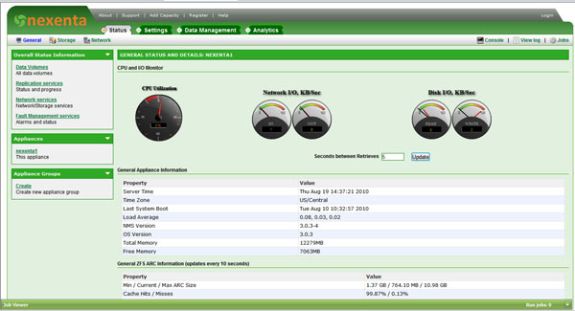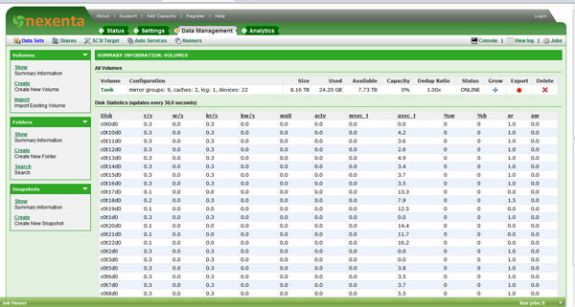ZFS - Building, Testing, and Benchmarking
by Matt Breitbach on October 5, 2010 4:33 PM EST- Posted in
- IT Computing
- Linux
- NAS
- Nexenta
- ZFS
Nexenta
Nexenta is to OpenSolaris what OpenFiler is to Linux or FreeNAS is to FreeBSD. It is a purpose built version of OpenSolaris designed primarily around storage networking including NFS, CIFS, and iSCSI/FC block based storage. Nexenta has taken a lot of time building a great front-end to manage ZFS enabled storage and integrate a plug-in manager that can extend the abilities of a standard x86 platform to rival the best
Nexenta comes in three flavors, Nexenta Core, Nexenta Community, and Nexenta Enterprise. The availability of these three versions allows you to select what kind of product you want, and what kind of expenditures that you will incur.
Nexenta Core is the most basic of the options, but it is also the most forgiving in terms of licensing. Nexenta Core is a command line interface platform only. It is based on an OpenSolaris kernel, and an Ubuntu Userland. There is no limit to the amount of storage that you can configure or use with Nexenta Core, and it is completely free. Nexenta Core can be found here.
Nexenta Community is the next step up. Nexenta Community is based on Nexenta Core, and includes a great GUI interface for managing all aspects of the storage platform. Nexenta Community is also free, but it is limited to 12TB of used storage. Nexenta Community Edition can be found here.
Nexenta Enterprise is the top-level offering. Nexenta Enterprise is a superset of Nexenta Community with many Enterprise level features, including support options. Nexenta Enterprise is licensed based on RAW storage capacity. You can find pricing information here.
Screenshots of web GUI
Nexenta has been very easy to use in our testing. After a few minutes of familiarization with the interface everything is pretty straight forward. You can go from a bare installation to something that has an array configured, an iSCSI target configured, and is ready to take data in a matter of 5-10 minutes. All of the features for sending out notifications and for lighting up indicator lights work as expected and are easy to configure. With just a few menu clicks you're ready to enter all of the information that the system needs to notify you about any problems that it encounters.
Some of the shortcomings that we saw in the Nexenta Enterprise offering were in the reporting and support areas of the product. We did not investigate the reporting problem in depth, as it was not pertinent to the performance data of the system. We would expect that with a little troubleshooting it would be something that would be easily resolved. Throughout the testing process though the daily reports stated that there was no network traffic being generated even though we were loading the interface quite heavily during testing.
This brings us to our next issue that we had with Nexenta, and that was the support channels. We would have gladly troubleshot the issues with reporting if we thought it was going to be done in a timely manner. Since we were using the Enterprise Trial license the support was lackluster at best. We were assured by sales representatives that paid-for support is much faster and much better than the "free trial" support. Free Trial support is treated as their lowest priority support queue. We were not impressed with this as we have always thought of a time-limited free trial period to be pre-sales. If you want to convert someone from a non-paying free trial to a paid product, show them how good the product and support is during that period.












102 Comments
View All Comments
diamondsw2 - Tuesday, October 5, 2010 - link
You're not doing your readers any favors by conflating the terms NAS and SAN. NAS devices (such as what you've described here) are Network Attached Storage, accessed over Ethernet, and usually via fileshares (NFS, CIFS, even AFP) with file-level access. SAN is Storage Area Network, nearly always implemented with Fibre Channel, and offers block-level access. About the only gray area is that iSCSI allows block-level access to a NAS, but that doesn't magically turn it into a SAN with a storage fabric.Honestly, given the problems I've seen with NAS devices and the burden a well-designed one will put on a switch backplane, I just don't see the point for anything outside the smallest installations where the storage is tied to a handful of servers. By the time you have a NAS set up *well* you're inevitably going to start taxing your switches, which leads to setting up dedicated storage switches, which means... you might as well have set up a real SAN with 8Gbps fibre channel and been done with it.
NAS is great for home use - no special hardware and cabling, and options as cheap as you want to go - but it's a pretty poor way to handle centralized storage in the datacenter.
cdillon - Tuesday, October 5, 2010 - link
The terms NAS and SAN have become rightfully mixed, because modern storage appliances can do the jobs of both. Add some FC HBAs to the above ZFS storage system and create some FC Targets using Comstar in OpenSolaris or Nexenta and guess what? You've got a "SAN" box. Nexenta can even do active/active failover and everything else that makes it worthy of being called a true "Enterprise SAN" solution.I like our FC SAN here, but holy cow is it expensive, and its not getting any cheaper as time goes on. I foresee iSCSI via plain 10G Ethernet and also FCoE (which is 10G Ethernet + FC sharing the same physical HBA and data link) completely taking over the Fibre Channel market within the next decade, which will only serve to completely erase the line between "NAS" and "SAN".
mbreitba - Tuesday, October 5, 2010 - link
The systems as configured in this article are block level storage devices accessed over a gigabit network using iSCSI. I would strongly consider that a SAN device over a NAS device. Also, the storage network is segregated onto a separate network already, isolated from the primary network.We also backed this device with 20Gbps InfiniBand, but had issues getting the IB network stable, so we did not include it in the article.
Maveric007 - Tuesday, October 5, 2010 - link
I find iscsi is closer to a NAS then a SAN to be honest. The performance difference between iscsi and san are much further away then iscsi and nas.Mattbreitbach - Tuesday, October 5, 2010 - link
iSCSI is block based storage, NAS is file based. The transport used is irrelevent. We could use iSCSI over 10GbE, or over InfiniBand, which would increase the performance significantly, and probably exceed what is available on the most expensive 8Gb FC available.mino - Tuesday, October 5, 2010 - link
You are confusing the NAS vs. SAN terminology with the interconnects terminology and vice versa.SAN, NAS, DAS ... are abstract methods how a data client accesses the stored data.
--Network Attached Storage (NAS), per definition, is an file/entity-based data storage solution.
- - - It is _usually_but_not_necessarily_ connected to a general-purpose data network
--Storage Area Network(SAN), per definition, is a block-access-based data storage solution.
- - - It is _usually_but_not_necessarily_THE_ dedicated data network.
Ethernet, FC, Infiniband, ... are physical data conduits, they are the ones who define in which PERFORMANCE class a solution belongs
iSCSI, SAS, FC, NFS, CIFS ... are logical conduits, they are the ones who define in which FEATURE CLASS a solution belongs
Today, most storage appliances allow for multiple ways to access the data, many of the simultaneously.
Therefore, presently:
Calling a storage appliance, of whatever type, a "SAN" is pure jargon.
- It has nothing to do with the device "being" a SAN per se
Calling an appliance, of whatever type, a "NAS" means it is/will be used in the NAS role.
- It has nothing to do with the device "being" a NAS per se.
mkruer - Tuesday, October 5, 2010 - link
I think there needs to be a new term called SANNAS or snaz short for snazzy.mmrezaie - Wednesday, October 6, 2010 - link
Thanks, I learned a lot.signal-lost - Friday, October 8, 2010 - link
Depends on the hardware sir.My iSCSI Datacore SAN, pushes 20k iops for the same reason that their ZFS does it (Ram cacheing).
Fibre Channel SANs will always outperform iSCSI run over crappy switching.
Currently Fibre Channel maxes out at 8Gbps in most arrays. Even with MPIO, your better off with an iSCSI system and 10/40Gbps Ethernet if you do it right. Much cheaper, and you don't have to learn an entire new networking model (Fibre Channel or Infiniband).
MGSsancho - Tuesday, October 5, 2010 - link
while technically a SAN you can easily make it a NAS with a simple zfs set sharesmb=on as I am sure you are aware.